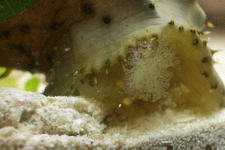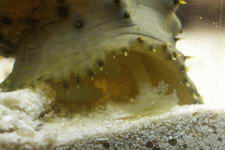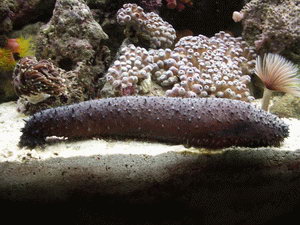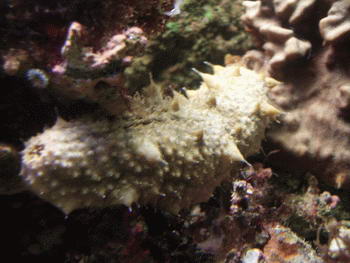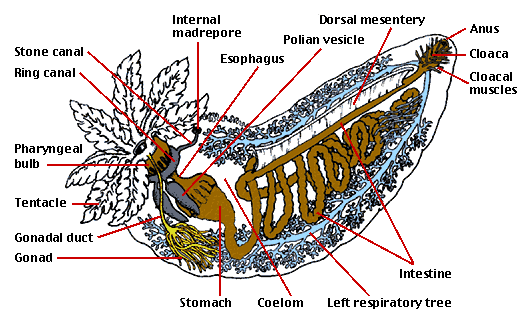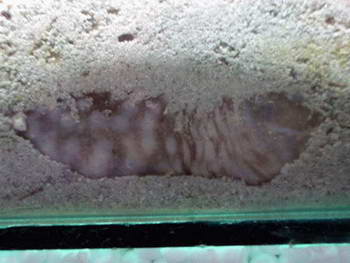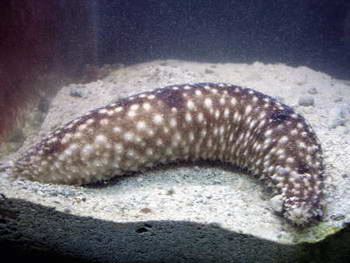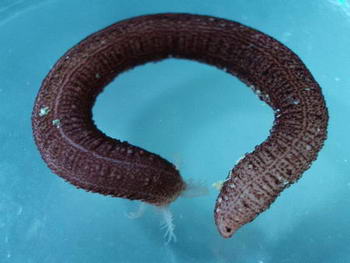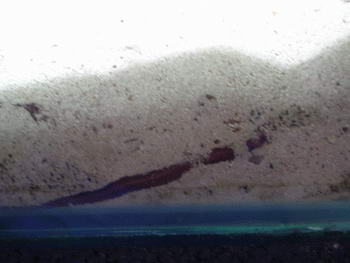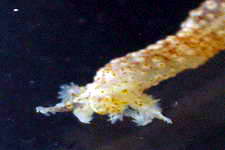While not actualy a worm, this family group of sea cucumbers get their nick name
simply
due to their long, skinny appearance and their lack of any obvious
legs, that, and having a crown of feeding appendages that stand out. I
see a great many Synaptids out on the sea grass beds crawling along
ever so slowly while they mop up the abundant organic debris. With no
visible means of propulsion (legs), I had often wondered at how they
move themselves across the substrates. It was my wife Linda who quite
by accident discovered how they do so. Having microscopic "hooks"
covering their skin, enables them to be very "sticky", which Linda
found out when her bare leg brushed against one while snorkeling and
had it stick to her. Needless to say, She did a fairly good imitation
of Jesus as she walked on water back to shore while screaming like a
girl. Being that "sticky" allows the synaptids to anchor any one
section of themselves and move across the substrates in an inch worm
fashion.
THE APODIDA : Contains about 269 species in 32 genera and three families. Tentacles are
digitate, pinnate or, in some small species, simple. Respiratory trees are
absent. Tube feet are completely absent. The calcareous ring is without
posterior projections. The body wall is very thin and often transparent. Found
in both shallow and deep water.
Sand Dwelling Species :
While searching through the near shore sand beds for various worm
species, I came across the species shown in the below photos. I
remembered how the surface dwelling species are very efficient at
collecting organic particles and thought that might the sand dwelling
types be as equally efficient.
Being that our
aquarium's deep sand beds are the only truly organic loaded environment
we have, and strive to maintain the sand infauna that keeps our deep
sand beds functional, I thought with these synaptids, I might be able
to avoid the possible problems that an organic laden sand bed might
cause to my aquarium system and collected three of them for my deep
sand bed. Having had them for quite a length of time now, I can say
that they are indeed a great benefit to my deep sand bed. They spend
their entire time moving slowly through entire depth of the sand bed
injesting the sand and cleaning it of any organics. Their movement
through the sand bed also ensures that there are no pockets of stagnant
water and sand while at the same time, slowly shifting the sand between
the upper and lower levels, preventing any formations of clumps.
I believe this single species will eventually become popular with
reef keeping hobbyists as a means to maintain deep sand beds with
little to no effort while enjoying not having to repopulate the normal
microscopic sand infauna, it appears that these synaptids easily
take over such roles. In due time, it is my hope to introduce these
synaptids to the hobby and make our keeping of marine systems a bit
easier and much more natural. Might then the deep sand bed critics be
forced to find a different dead horse to beat upon.



